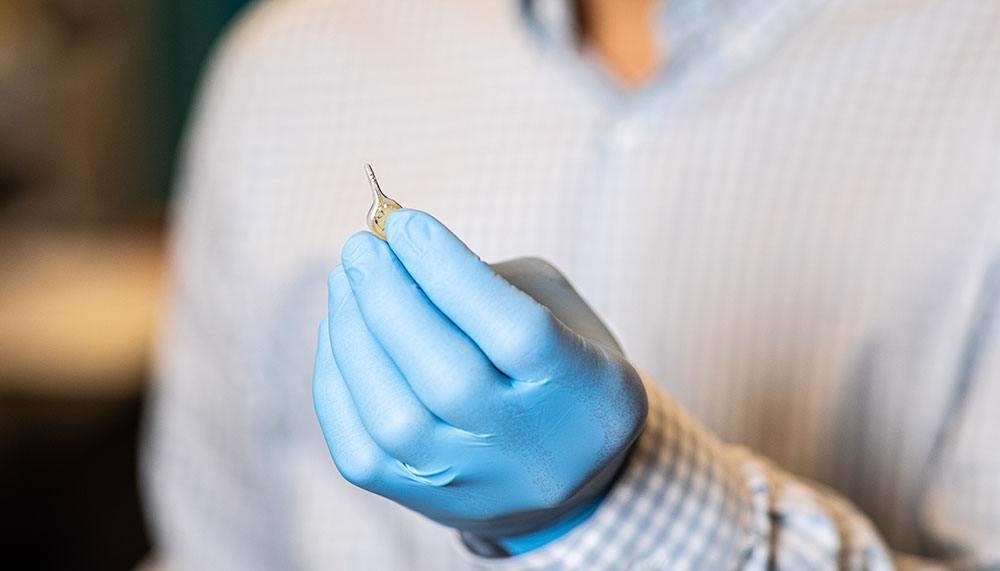Surgery has been the sole option for those diagnosed with colorectal cancer. However, surgery is often complicated by disease relapse at the original site where the tumor was found when residual microscopic tumor cells are left behind during surgery. Although it can lead to harmful side effects, chemotherapy is a treatment choice that is frequently given along with surgery.
 The small device is designed to enable a more individualized application of light dosing and photodynamic therapy. Image Credit: Justin Baetge/Texas A&M Engineering.
The small device is designed to enable a more individualized application of light dosing and photodynamic therapy. Image Credit: Justin Baetge/Texas A&M Engineering.
Developing an inexpensive, minimally invasive wireless device offering specific, safe treatment alternatives for cancers is the key area of focus for Sung II Park, assistant professor in the Department of Electrical and Computer Engineering and scientist in the Center for Remote Health Technologies and Systems at Texas A&M University and his team.
The scientists will apply photodynamic therapy (PDT) during surgery by utilizing a photosensitizer — a drug stimulated by light — to destroy the cancer cells.
During this procedure, surgeons can extract the bulk of the tumor, then completely irradiate the tumor bed when the photosensitizer is stimulated by the light. This combination would deliver treatment in a safe and effective manner without any harmful side effects.
The biocompatible, miniaturized implantable LED device will enable light dosing and PDT that is tailored to the individual tumor response.
Sung II Park, Assistant Professor, Department of Electrical and Computer Engineering, Texas A&M University
With further research, the researcher’s efforts will result in a system that has the prospect to offer clinical-quality health tracking capabilities for uninterrupted use outside the confines of the conventional hospital or lab facilities; it will also enable treatment options to stop the advance of further malignancy and thus considerably enhancing the quality of life for patients with cancer.
This kind of system would also decrease the massive economic burden on oncology resources, which equaled $167 billion in just 2020. In 2022, estimated worldwide oncology spending will reach $206 billion, a 23.35-percent rise.
More details regarding their device have been reported in the April issue of the journal Nature Communications.
According to the American Institute for Cancer Research, apart from skin cancers, colorectal cancer is the third most frequently occurring cancer globally. According to the American Cancer Society, this year, around 149,500 adults in the US will be diagnosed with colorectal cancer and it is anticipated to cause approximately 52,980 deaths.
Although photodynamic therapy has proven to be positive in a number of solid tumor cancers, its clinical application has been restricted by a partial understanding of the differing response of cancer and healthy tissue, and a lack of techniques to track tumor response and regulate light dosage because of that.
To resolve this gap, Park and his team have suggested a two-step process. The first step is the administration of the photosensitizer drug, which is preferentially absorbed by the cancer cells. The second step is the irradiation of the tumor with non-thermal light at a wavelength that equals the drug’s absorption spectrum. Drug activation triggers a photochemical reaction that causes tumor cell destruction.
The intracavity device will provide a minimally invasive, biocompatible platform for light detection of residual cancers and delivery to tumor cells located in any part of the body, suggesting it could make an impact in the areas of breast, kidney, lung, pancreatic, prostate, ovarian and rare cancers.
Sung II Park, Assistant Professor, Department of Electrical and Computer Engineering, Texas A&M University
Other contributors to the study include several renowned scientists from the Department of Electrical and Computer Engineering of Sun Moon University and the University of Leeds.
This study received support through grants from the interdisciplinary X-Grants Program, part of the President’s Excellence Fund at Texas A&M, the 2018 National Alliance for Research on Schizophrenia and Depression Young Investigator Awards from the Brain and Behavior Research Foundation, and the Precise Advanced Technologies and Health Systems for Underserved Populations Engineering Research Center.
This study also received support from a National Institute for Health Research (NIHR) Research Professorship, Wellcome Trust Institutional Strategic Support Fund Fellowship, and an NIHR Senior Investigator Award.
Journal Reference:
Kim, W. S., et al. (2022) AI-enabled, implantable, multichannel wireless telemetry for photodynamic therapy. Nature Communications. doi.org/10.1038/s41467-022-29878-1.